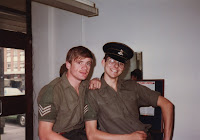Queen Elizabeth 2 (QE2)
 First was the QE2 which took me from the UK to South Georgia. She was a wonderful ship with a crew that treated us like royalty and of course as an 18 year old I had never experienced such luxury before. At that time in my life I had only been on ferries to either Ireland or France.
First was the QE2 which took me from the UK to South Georgia. She was a wonderful ship with a crew that treated us like royalty and of course as an 18 year old I had never experienced such luxury before. At that time in my life I had only been on ferries to either Ireland or France.She is still in operation today on the cruise circuit, in fact when I checked yesterday she was off the east coast of Canada.
Website for the QE2
Canberra
 On arrival in South Georgia we cross decked to the Canberra which took us into San Carlos water and from which we were moved by landing craft to San Carlos. I remember the huge seas and being strapped to the side rails with a climbing harness so we wouldnt get washed overboard when I manned the GPMG's that we used as defence against air attack.
On arrival in South Georgia we cross decked to the Canberra which took us into San Carlos water and from which we were moved by landing craft to San Carlos. I remember the huge seas and being strapped to the side rails with a climbing harness so we wouldnt get washed overboard when I manned the GPMG's that we used as defence against air attack.She was sold for scrap in 1997.
Website for the Canberra
MV St Edmund
 The battalion got to spend a few days aboard her when she was docked in Port Stanley just after the ceasefire. I remember going aboard and being met by a Royal Navy party who gave us all a tot of rum and then led us to cabins where we were told to get a shower and then sleep. It was the first shower since landing so was the first wash we had had in 2 weeks. It was also the first nights sleep in a bed. We all crashed out for 24 hours and when we woke up found that the Navy had washed all our clothes overnight for us. I can't tell you how good that made us feel. It was like being welcomed back into the human race.
The battalion got to spend a few days aboard her when she was docked in Port Stanley just after the ceasefire. I remember going aboard and being met by a Royal Navy party who gave us all a tot of rum and then led us to cabins where we were told to get a shower and then sleep. It was the first shower since landing so was the first wash we had had in 2 weeks. It was also the first nights sleep in a bed. We all crashed out for 24 hours and when we woke up found that the Navy had washed all our clothes overnight for us. I can't tell you how good that made us feel. It was like being welcomed back into the human race.She is still in use though not as the MV St Edmund, she is now called Sciroco and operates between Almeria, Southern Spain and Nador, North Morocco.
Website for the MV St Edmund
MV Norland
 When we finally went home it was to be aboard the Norland. This is the ship that took most of the Paras to war and was to be our ride home. She rolled and wallowed like a pig in the South Atlantic and most of the guys stayed in bed. I remember sitting in the dining area playing solitaire looking out the windows at the grey sea and watching the horizon go from grey sky to grey sea for hours on end. I also remember the crew especially one called "Wendy" who was quite a hit with some of the guards.
When we finally went home it was to be aboard the Norland. This is the ship that took most of the Paras to war and was to be our ride home. She rolled and wallowed like a pig in the South Atlantic and most of the guys stayed in bed. I remember sitting in the dining area playing solitaire looking out the windows at the grey sea and watching the horizon go from grey sky to grey sea for hours on end. I also remember the crew especially one called "Wendy" who was quite a hit with some of the guards.She is still in use today though not as the MV Norland. She was renamed SNAV Sicilia and now operates the route between Naples and Palermo.
Website for the MV Norland
I also spent a night on HMS Fearless and I visited one of the frigates that came into Ajax Bay though I have no idea which one. Maybe I can get to find that out, I will keep you posted.





 All dressed up and wearing my regimental tie (for the first time ever!) I headed over to the London Scottish Drill Hall where the reunion dinner for the 2nd Battalion Scots Guards had been arranged.
All dressed up and wearing my regimental tie (for the first time ever!) I headed over to the London Scottish Drill Hall where the reunion dinner for the 2nd Battalion Scots Guards had been arranged.











